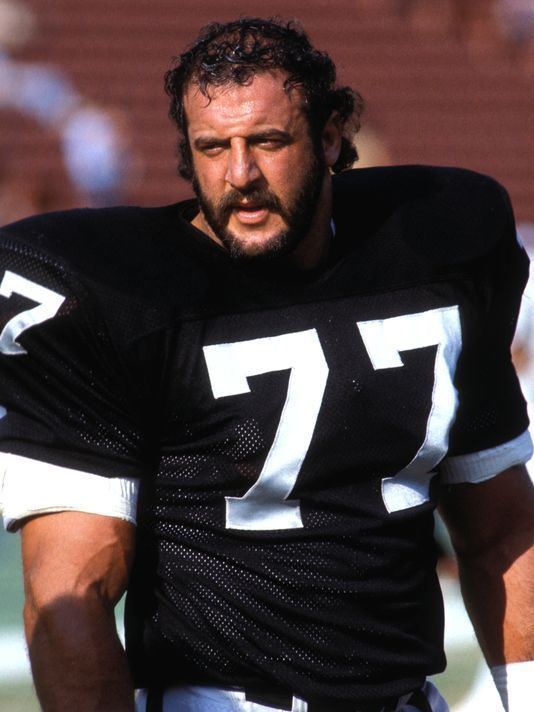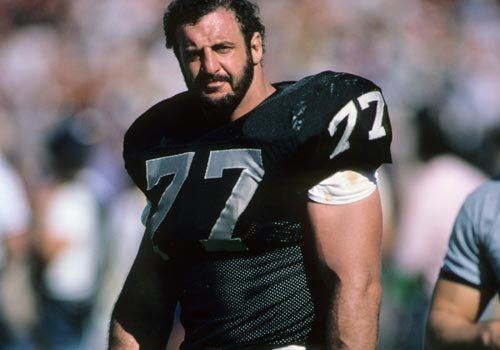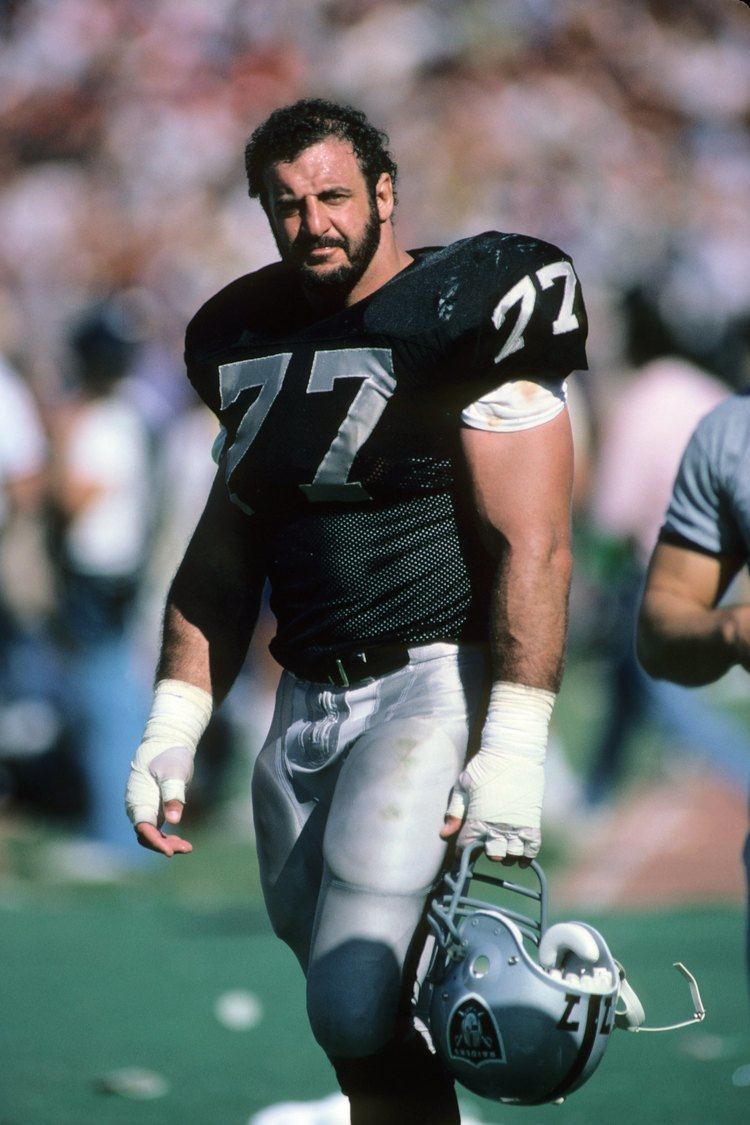Position: Defensive end Name Lyle Alzado Height: 6 ft 3 in (1.91 m) | ||
 | ||
Date of birth: (1949-04-03)April 3, 1949 Date of death: May 14, 1992(1992-05-14) (aged 43) Died May 14, 1992, Portland, Oregon, United States Spouse Kathy Alzado Murray (m. 1991–1992), Kris Alzado (m. 1987–1989), Cindy Alzado (m. 1984–1985) Movies and TV shows Similar People John Matuszak, Howie Long, Jack Tatum, Dave Casper, George Blanda | ||
Lyle Alzado: Football Defensive End
Lyle Alzado pitching JB's Pigskins
Lyle Martin Alzado (April 3, 1949 – May 14, 1992) was a professional American football defensive end of the National Football League famous for his intense and intimidating style of play.
Contents
- Lyle Alzado Football Defensive End
- Lyle Alzado pitching JBs Pigskins
- Early life
- College
- Denver Broncos
- Cleveland Browns
- Los Angeles Raiders
- Style of play
- Outside of football
- Steroid use and death
- References

He played 15 seasons, splitting his time among the Denver Broncos, the Cleveland Browns, and finally the Los Angeles Raiders with whom he won a championship in Super Bowl XVIII.

Early life

He was born in Brooklyn, New York, to an Italian-Spanish father and an ethnically Jewish mother. His last name was pronounced, Al-Zah-Doe, but became known as Al-Zay-Doe, during his pro football career. When he was 10, the family moved to Cedarhurst, Long Island. His father, whom Alzado later described as "a drinker and street fighter," left the family during Alzado's sophomore year at Lawrence High School. He played high school football and was a Vardon Trophy Candidate (defense) in high school for three years.
College

Following his failure to receive a college scholarship offer, Alzado played for Kilgore College, a junior college in Kilgore, Texas. After two years, he was asked to leave the team, he later contended, for befriending a black teammate. From Texas, Alzado moved on to Yankton College in South Dakota, a now-defunct school whose campus is currently the site of a federal prison. Though playing in relative obscurity in the NAIA, Alzado nonetheless gained notice by the NFL when a scout for the Denver Broncos, having been taken off the road by automobile trouble, decided to pass the time by screening a film of Montana Tech, one of Yankton's opponents. Impressed by the unknown player squaring off against Montana Tech's offense, the scout passed back a favorable report to his team. The Broncos ultimately drafted Alzado in the fourth round of the 1971 draft. Alzado went back to Yankton after his rookie season to get his college degree. He received a B.A. in physical education with an emphasis in secondary education. During his college years, Alzado participated in amateur boxing, and made it to the semi-finals of the 1969 Midwest Golden Gloves Boxing Tournament, held in Omaha.
Denver Broncos

When the Broncos' starting right defensive end Rich "Tombstone" Jackson was injured in 1971, Alzado took over the job and went on to make various All-rookie teams for his contributions of 60 tackles and 8 sacks. The following year, Alzado began to get national attention as he racked up 10½ sacks to go with his 91 tackles. In 1973, Alzado posted excellent numbers as the Broncos had a winning record for the first time in team history with a 7–5–2 mark.
In 1974, Alzado gained more notice as one publication named him All-AFC, with his 13 sacks and 80 tackles (eight for a loss) he was being recognized with the NFL's top defensive ends, such as Elvin Bethea, Jack Youngblood, L. C. Greenwood, Claude Humphrey, and Carl Eller. The Denver Broncos posted their second consecutive winning season, going 7–6–1.
The 1975 season brought change, as Alzado moved to defensive tackle. He responded with 91 tackles and 7 sacks. Alzado took a step backward as did the Broncos with a 6–8 record. On the first play of the 1976 season, Alzado blew out a knee and missed that campaign. The Broncos were 9–5 but SPORT magazine reported that 12 players, including Alzado, did not think the team could reach the playoffs with coach John Ralston. Ralston was replaced as coach by Red Miller for the 1977 season.
The 1977 season was the most successful in franchise history to that point; the Broncos had one of the NFL's best defenses, went 12–2 and then beat Pittsburgh Steelers and Oakland Raiders, the team with which he would later star, in the playoffs to reach Super Bowl XII. In that game, played in New Orleans, they were beaten soundly 27–10 by the Dallas Cowboys. Still, the year was a big success for Alzado, who was voted consensus All-Pro and consensus All-AFC as well as winning the UPI AFC Defensive Player of the Year. He also led the Broncos in sacks with 8, while making 80 tackles.
In 1978, the Broncos again went to the AFC playoffs, but lost the rematch in the first round to the eventual champions Steelers. Alzado had 77 tackles and 9 sacks and recorded his first NFL safety. (Alzado would record two more in his career, which ties him in second place all-time). He was 2nd team All-Pro and a consensus All-AFC pick. In 1979, he had a contract dispute, and the Broncos traded him to the Cleveland Browns.
Cleveland Browns
Alzado played well with the Browns, making second team All-AFC in 1979 while playing defensive end. He had 80 tackles that year to go with his seven sacks. The following year, the Browns won the AFC Central division, losing to the Raiders in the Divisional round. Alzado led the Browns in sacks with nine, and was All-Pro and All-AFC. In 1981, he suffered some injuries, and at times his focus on football was diminished because of problems in his private life. Still, he recorded 83 tackles and led the Browns in sacks with 8½. However, the Browns, who fell from 11-5 in 1980 to 5-11 in 1981, traded him to the Oakland Raiders in 1982.
Los Angeles Raiders
Being discarded by the Browns rekindled a fire in Alzado, and he worked out with a vengeance. In 1982, he was voted the NFL Comeback Player of the Year. Although he played a full season in 1981, his play was seemingly so superior in 1982 that he garnered the award. In the strike-shortened 1982 season of 9 games, Alzado recorded 7 sacks and 30 tackles while being voted All-AFC. This was the sixth season out of his first 12 campaigns that he received some sort of post-season honor.
He continued to perform well for the Raiders in the 1983 season, helping lead them to a Super Bowl victory that year while recording 50 tackles and 7½ sacks. He also had an outstanding 1984 season with 63 tackles and 6 sacks, but the next year his tackle and sack totals dipped to 31 and 3 following a mid-season injury.
Alzado retired at the end of the 1985 season. He attempted a comeback in 1990, but injured a knee during training camp and was released. In 196 career games, he racked up 112.5 sacks, 24 forced fumbles, and nearly 1,000 tackles, while earning Pro Bowl honors in 1977 and 1978. Following his retirement from playing, Alzado worked as a part-time color analyst for NBC's NFL coverage in 1988–89.
Style of play
Indeed, the man whom ESPN would later find a "violent, combative player known for his short temper" inspired the league rule against throwing a helmet after having done so himself to an opponent's helmet. Peter Alzado, Lyle's brother, later identified the years of their youth—marked by an absent, alcoholic father and an over-worked mother—as the crucible for Alzado's unremittingly fierce style of play. "That violence that you saw on the field was not real stuff," his brother held. "Lyle used football as a way of expressing his anger at the world and at the way he grew up." Defensive end Greg Townsend, a teammate on the Raiders, contended that the savagery for which Alzado became noted represented only part of a "split personality." "Off the field," remembered Townsend, "he was the gentle giant. So caring, so warm, so giving."
Outside of football
Steroid use and death
Alzado was one of the first major US sports figures to admit to using anabolic steroids. In the last year of his life, as he battled against the brain tumor that eventually caused his death, Alzado asserted that his steroid abuse directly led to his fatal illness. Alzado recounted his steroid abuse in an article in Sports Illustrated,
The role that anabolic steroids may have played in Alzado's death has been the subject of controversy. The lymphoma of the brain that took his life has not been associated clinically with steroid use. The claim was denounced as a myth in the 2008 documentary Bigger, Stronger, Faster and by Wisconsin pediatrician and steroid expert Norm Fost.
Lyle Alzado died on May 14, 1992 at age 43 after a battle with brain cancer. He was buried at River View Cemetery in Portland, Oregon.
